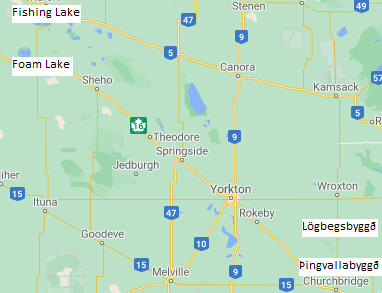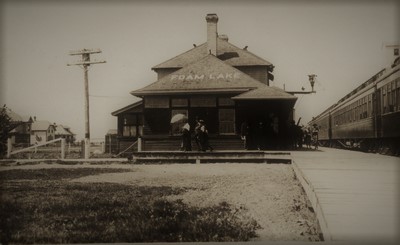
In 1882, an English fur trader, Joshua Milligan, was the first to settle by a lake naming it Foam Lake when he saw foam forming along the shore of this shallow lake. Not much is known about this man or others like him in the area at that time. When plans had been completed for a new railway from Yorkton south of the Quill Lakes, explorers began to show interest in this part of the Northwest Territories.
Icelandic explorers – new settlement: In the spring of 1891, settlers in Thingvalla-Lögberg Settlements were increasingly concerned with the lack of water in the district. They wondered if their land selections had been in a particularly dry part of the prairie. The number of livestock was growing every year, especially cattle and sheep. Groups of explorers, who were returning to Winnipeg after explorations north and west of the Icelandic settlements, told of lakes west and north of Yorkton. Two farmers in Thingvalla Settlement decided to travel and examine these regions. One was Ingimundur Eiríksson from Árnessýsla, the other Kristján Helgason from Eyjafjörður. They set out with a team of horses and wagon and supplies. After a few days journey they arrived at Fishing Lake, having covered some 180 km (112 miles). The lake was average in size on the south side of which grew tall grass in a good size meadow, and tall poplars grew on higher land further away. Plenty of hay to be cut and there was enough building material for several homes and barns and, most of all, no shortage of water. Upon arrival back home both men gave the positive reports of the new region. After a few week’s preparations, on June 27, 1892, three families and one single man, Lafrans Jónsson from Árnessýsla headed out. The families consisted of Ingimundur Eiríksson from Árnessýsla, his wife Steinunn Ólafsdóttir and their children. Along with them came Gróa Ásbjarnardóttir, Ingimundur´s mother. Gísli Jónsson Bíldfell and his wife, Valgerður Eiríksdóttir, sister of Ingimundur’s sister, and their children, and finally Bjarni Jasonarson from Árnessýsla and his wife, Guðrún, who was also Ingimundur´s sister. In the fall one more sister, Guðfinna, and her husband, Sveinn Halldórsson, arrived in the new colony and a little later, Stefán Ólafsson arrived from the Thingvalla Settlement with his wife Guðrún Hinriksdóttir. The settlers realized that there was not enough time to build huts for each family so one good log cabin with sod roof was built and a barn. A section of the barn was partitioned off for Stefán Ólafson and family, Lafrans shared the other part of the barn with the livestock. The others shared the log house, a total of nine adults and six children.
Foam Lake: The settlers brought their livestock, cattle, sheep and horses, as well as oxen so making hay was highest on the agenda. Together all worked until enough hay had been gathered for the winter but not long afterwards a prairie fire swept through and destroyed all the hay. With little time to lose, men went about looking for grassy meadows and found a large one. This actually was Foam Lake, now bone dry in the middle of the dry cycle. Only one mower had been brought along and after a day or two it broke down. This was bad news; grass was ripening fast and soon mold would begin to show, making the hay useless. Gisli Bildfell saddled his best horse, rode to Saltcoats, the closest village, a distance of 140 km (87 miles), in one day to get spare parts. These had to be ordered from Winnipeg, so Gisli needed to wait two days. Once he had them, he hurried back to find everyone hard at work, men using scythes for cutting and women using homemade rakes. Winter arrived and men had to fetch hay, a distance of 10 km (6 miles), so a team of oxen were used to pull the sledge. The winter convinced the settlers that a move closer to the lake made sense, so by fall of 1894 everyone had left the Fishing Lake site and relocated to Foam Lake.

Foam Lake Railway Station Photo Prairie Towns
New arrivals: As news reached Icelanders in various locations in the Territories, several began to contemplate a move. Kristján Helgason, the same who originally explored the Foam Lake area along with Ingimundur had settled at White Sand River, close to Theodore village (see map above). He decided in 1897 to move to Foam Lake as he wanted to live near his fellow countrymen. With him travelled his in-laws, namely Jóhannes Bjarnason and Lilja Daníelsdóttir. Thorsteinn Thorsteinsson from E. Skaftafellssýsla made the same decision a year later and moved with his wife, Anna Ingibjörg Jónsdóttir, he also had settled by White Sand River. Tómas Þórðarson (Thomas Paulson) and his wife, Thorunn Jóhannesdóttir in the Thingvalla Settlement moved to Foam Lake in 1898 and a year later, Guðbrandur Narfason and his wife, Anna Margrét Eiríksdóttir settled in Foam Lake. By the turn of the century, land all around the lake had been settled and the lake was gradually returning to normal as water continued to flow and in 1902 it was back to normal size. That same year the settlement around the lake had expanded as a few families had arrived, but during the period 1903-1905 a considerable influx of new settlers took place. In 1907 the railway reached the small village and ran onwards north and west south of the Quills.
English version by Thor group.
